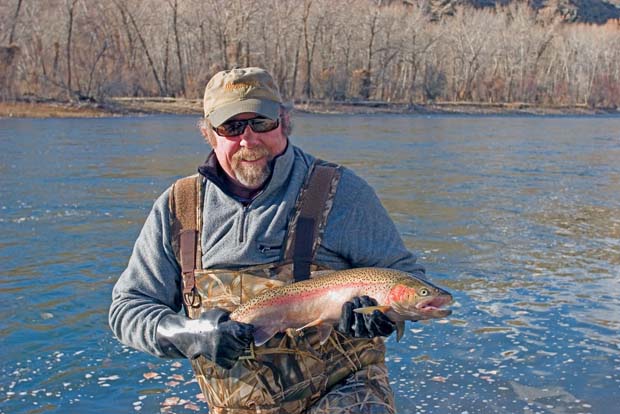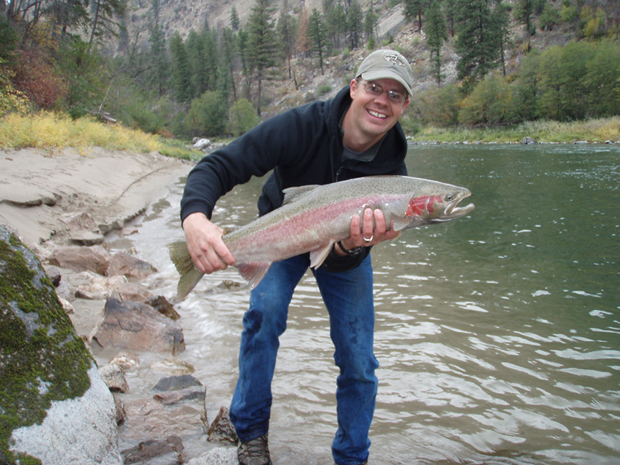[dropcap]N[/dropcap]aturally born steelhead trout of both “winter” and “summer” stocks from the Columbia/Snake river system that try a second run at spawning do much better than their hatchery origin peers, according to preliminary research results presented Tuesday at the U.S. Army Corps of Engineers Anadromous Fish Evaluation Program annual review in Walla Walla, Wash.
“Wild fish from both the Snake and Columbia had much higher return rates,” said Matthew Keefer of the University of Idaho’s Department of Fish and Wildlife Sciences.
He and fellow UI researcher Christopher Caudill led the evaluation of migration histories from 53,282 PIT-tagged adult steelhead detected at Bonneville Dam over 11 adult migration (2000-2010) years.
In total, seven winter steelhead and 132 summer steelhead were considered to have initiated a second spawning migration based on appropriately-timed detections at Bonneville Dam in two migration years.
The research was intended to “(1) use the migration histories in the Columbia River PIT Tag Information System (PTAGIS) to estimate ‘baseline’ iteroparity rate estimates for a variety of Columbia and Snake River steelhead populations; (2) compare iteroparity rates among steelhead life history types (winter, summer), origin types (wild, hatchery), and age classes; and (3) evaluate whether iteroparity rates have increased through time as SFO operations have increased.”
Steelhead, like salmon, swim to the ocean where they mature, and then return to the freshwater to spawn and produce a next generation. Steelhead, however are capable of repeat spawning (iteroparity). Salmon, on the other hand die soon after spawning a first time.
SFOs are surface flow outlets – the surface bypass facilities at mainstem dams for migrating salmon and steelhead.
Repeat steelhead spawners, called kelt, are prized. That second go-round provides genetic and demographic benefits to populations by providing additional mates. That leads to more genetic crosses – increased diversity that is desired to help sustain populations — as well larger effective population size.
The kelt also have higher lifetime production and individually produce more eggs.
Increasing iteroparity “is desirable for management and conservation objectives,” Keefer said.
Snake River, lower, mid and upper Columbia and Willamette River wild steelhead stocks are listed under the Endangered Species Act.
“Tens of thousands of kelt start downstream,” but survival of the spawned-out fish is low, Keefer said.
So-called steelhead trout kelt are looked to as a part of the effort to recover species.
“A variety of management approaches have been undertaken to increase kelt survival and the expression of iteroparity in Columbia River steelhead over the last decade. These include increased operation of surface flow outlets (SFOs) for kelts at many FCRPS dams,” according to a draft report detailing iteroparity study.
Radio and acoustic telemetry studies have shown that kelts use SFOs (Khan et al. 2010; Colotelo et al. 2013) and that fish that pass via these routes have a survival advantage over those that pass via turbines.
“With all years combined, Bonneville-to-Bonneville iteroparity estimates for the primary life history origin groups were: 2.78 percent (winter, wild), 0.44 percent (winter, hatchery), 0.56 percent (summer, wild), and 0.16 percent (summer, hatchery),” according to the preliminary data presented by the researchers. Qualifying fish must have been detected at the dam in two different years.
The data analysis indicates that “iteroparity rates for wild steelhead decreased as freshwater migration distance increased, presumably reflecting higher kelt mortality for interior Columbia and Snake River populations.”
The data also seems to indicate that “more flow means better kelt survival” for wild fish, Keefer said. “This is not a surprising result.”
He said it was still unclear, based on the study analysis, how much surface bypass options installed over the past 10 years at dams up and down the Columbia-Snake system help boost kelt survival. The surface bypass systems have been installed largely to provide a more natural route of passage downstream for juvenile salmon and steelhead.
“There was limited, indirect evidence that installation and increased operation of SFOs contributed to increasing iteroparity rates over the study period,” according to a research abstract produced for the AFEP review.
“The goal of kelt management actions are to improve survival and productivity of listed steelhead by facilitating kelt survival through transport, in-river migration improvements, and reconditioning,” according to the 2013 draft Comprehensive Evalution report prepared by the Corps, Bonneville Power Administration and Bureau of Reclamation. The report sums up progress towards implementation of NOAA Fisheries 2008 ESA biological opinion.
“Kelt reconditioning is the process of collecting steelhead during their seaward migration, containing them in a hatchery setting, and rehabilitating the fish through special diets and treatment of pathogens. Fish are then released back into the collection stream(s) to spawn.
“The first successful release of natural-origin reconditioned Snake River B-run steelhead occurred in 2012, contributing to the FCRPS BiOp goal of a 6 percent increase in Snake River B-run female steelhead abundance,” the evaluation report says.
The Corps has sponsored biological studies continuously since 1952 in an integrated, applied research program. This program is intended to enhance understanding and improve anadromous fish passage conditions at multi-purpose projects on the Columbia and lower Snake Rivers in Oregon and Washington. The monitoring, research and evaluation studies are managed under the AFEP.
To read complete story click here […]



